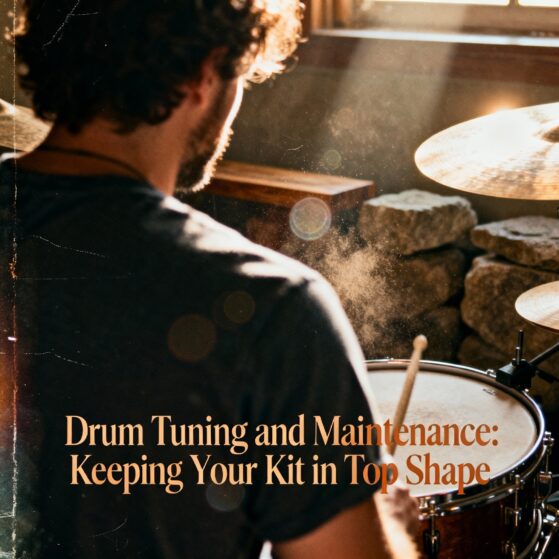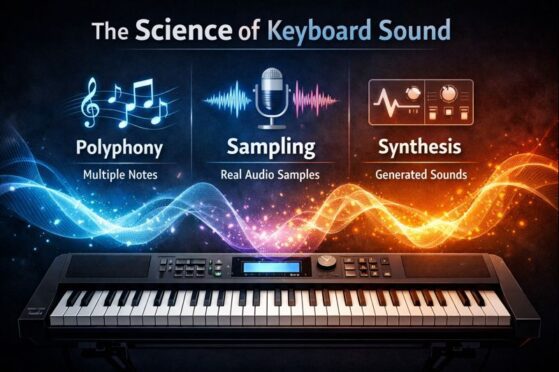The Evolution of Music | From Ancient Melodies to Modern Rhythms
The Evolution of Music has continuously shaped human history, connecting cultures and emotions across generations. As a result, music has transformed from simple rhythms into complex compositions. Over time, each era introduced new styles, instruments, and technologies. Consequently, these changes influenced artistic expression, social movements, and cultural identity.
Since ancient times, music has played a vital role in storytelling and rituals. Therefore, early civilizations used natural sounds and handmade instruments to create melodies. Similarly, religious and ceremonial music developed unique structures, preserving traditions while inspiring future generations. Eventually, written notation allowed compositions to be shared and refined.
Moreover, technological advancements revolutionized the way people create and experience music. Because of recording innovations, global audiences could access different genres instantly. In addition, digital platforms enabled independent artists to reach listeners worldwide. Ultimately, the Evolution of Music continues, blending tradition with innovation while shaping the future of sound.
Music in Ancient Times
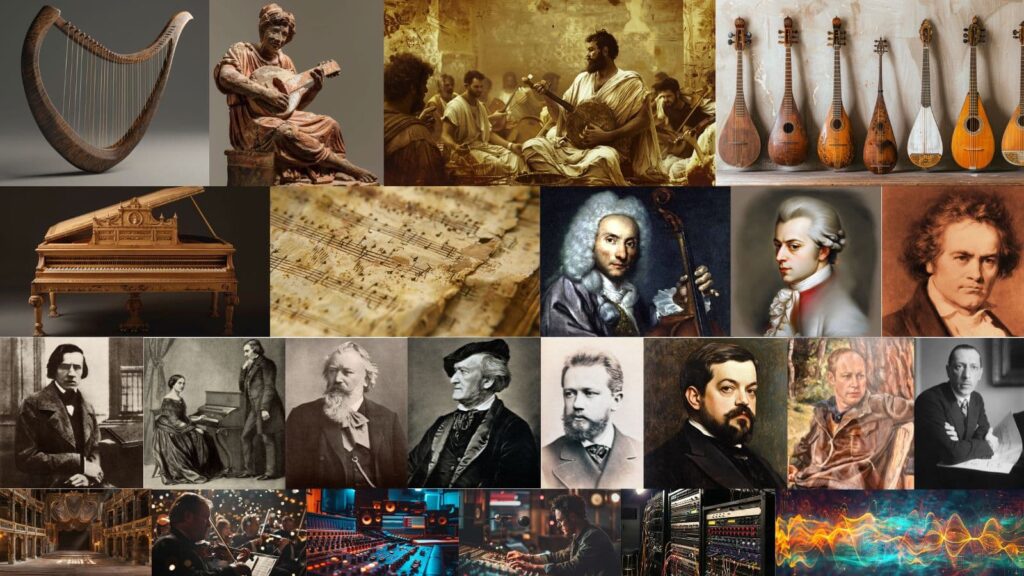
The Evolution of Music in Early Civilizations
Early humans created music using natural elements like wind, water, and animal sounds. They clapped hands, struck stones, and used hollow logs as drums. Over time, simple instruments emerged, including bone flutes, rattles, and stringed devices.
Archaeological discoveries suggest that music played an essential role in early communities. Ancient Mesopotamians, Egyptians, Greeks, and Chinese civilizations developed structured musical traditions. They used harps, lyres, and percussion instruments to accompany rituals, storytelling, and entertainment.
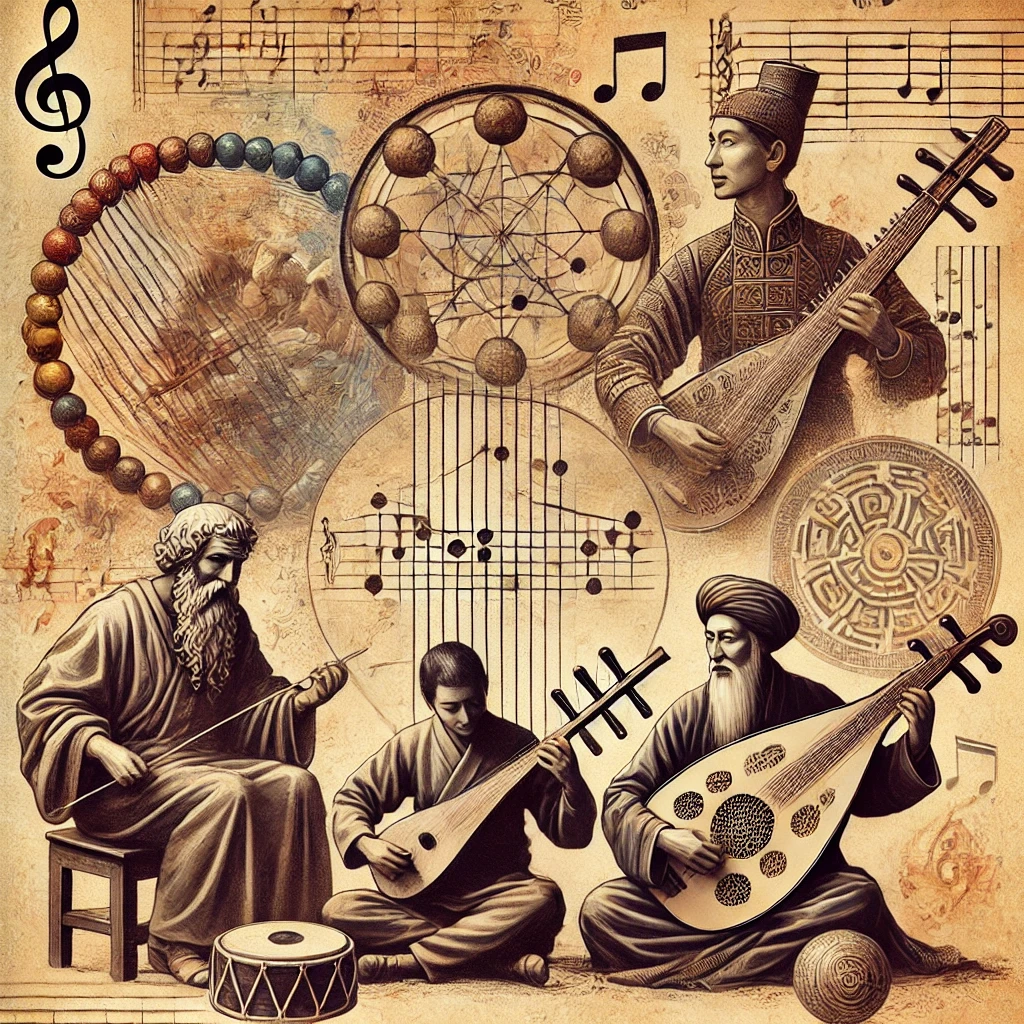
Greek philosophers such as Pythagoras studied musical scales, linking music to mathematical harmony. In China, the pentatonic scale became a foundation for traditional compositions. Indian and Middle Eastern civilizations also developed distinct musical systems, using stringed instruments like the sitar and oud.
Music in early civilizations was more than entertainment. It conveyed stories, passed down traditions, and influenced social structures. As cultures expanded, musical exchange between regions enriched styles and techniques, laying the foundation for future developments.
The Evolution of Music in Religious and Ritualistic Practices
Music has always played a significant role in spiritual and religious life. Ancient societies used music in ceremonies, rituals, and communal gatherings. Rhythmic drumming, chanting, and hymns created a deep connection between individuals and their beliefs.
In Hindu traditions, devotional songs, or bhajans, accompanied temple rituals. In Christianity, Gregorian chants developed in monasteries, enhancing worship experiences. Buddhist monks incorporated melodic chanting in meditation practices. Indigenous cultures worldwide also used sacred songs in healing and spiritual ceremonies.
Religious institutions helped preserve and refine musical traditions. Many early musical notations originated in religious contexts, allowing compositions to be recorded and passed down through generations. This influence shaped classical compositions in later periods, linking sacred music to artistic development.
Throughout history, religious music adapted to cultural changes while maintaining its significance. It remains a powerful force, inspiring both traditional and contemporary musical expressions.
Medieval and Renaissance Era Music
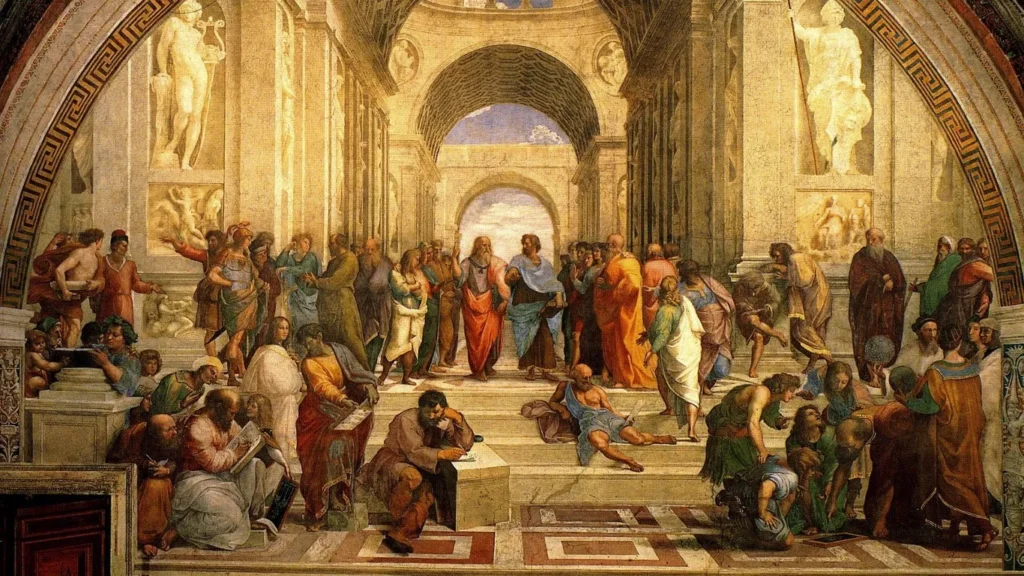
The Evolution of Music in the Medieval Period
The medieval period (500–1400 AD) marked significant advancements in musical notation and composition. Before this era, music was primarily passed down through oral tradition. With the development of written notation, musicians could document melodies and share them across regions.
Gregorian chants, named after Pope Gregory I, became the dominant form of religious music. These monophonic melodies, sung in Latin, were designed for church services and liturgical purposes. Monasteries and cathedrals served as key centers for musical development, preserving sacred compositions.
Secular music also gained popularity. Traveling musicians, known as troubadours and minstrels, performed folk songs and poetic ballads. Instruments such as the lute, harp, and early versions of the violin accompanied these performances. Unlike sacred music, secular compositions focused on themes of love, chivalry, and storytelling.
As the medieval era progressed, polyphony emerged. This technique, which involved multiple independent vocal lines, added depth and complexity to compositions. The Notre Dame School in France played a crucial role in developing polyphonic music, influencing later European styles.
By the end of the medieval period, music had evolved into a more structured and expressive art form. The foundation laid during this era allowed for further innovation in the Renaissance.
The Evolution of Music in the Renaissance Era
The Renaissance (1400–1600 AD) brought a revival of artistic and intellectual exploration. Music became more expressive, structured, and harmonically rich. Composers experimented with different vocal arrangements, creating intricate choral compositions.
One of the most significant developments was the use of imitative polyphony, where musical phrases repeated across different vocal parts. Composers like Josquin des Prez and Palestrina mastered this technique, producing elegant and balanced compositions.
The invention of the printing press in the 15th century revolutionized music distribution. Printed sheet music allowed compositions to reach a broader audience. This advancement helped spread musical styles across Europe, encouraging greater collaboration among musicians.
Secular music flourished alongside sacred compositions. Madrigals, lively songs with poetic lyrics, gained popularity in Italy and England. Instrumental music also advanced, with the development of early keyboard instruments such as the harpsichord and clavichord.
The Renaissance era laid the groundwork for future musical styles. Its emphasis on harmony, notation, and structured compositions influenced the Baroque and Classical periods.
Baroque and Classical Era Music
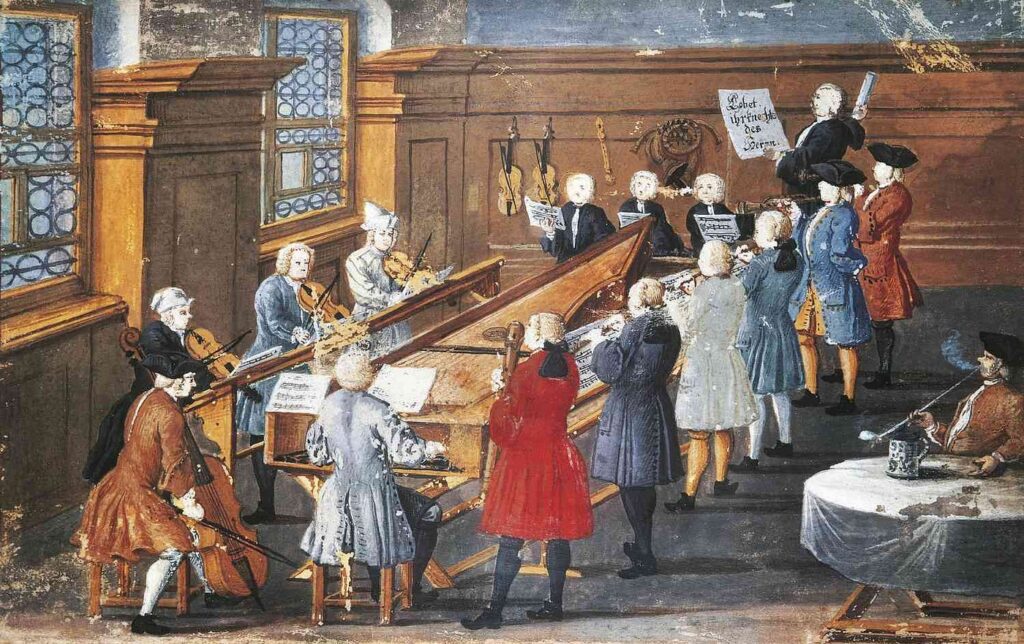
The Evolution of Music in the Baroque Period
The Baroque period (1600–1750 AD) introduced dramatic contrasts, ornate melodies, and emotional expression. Composers aimed to create music that evoked strong feelings, using complex harmonies and dynamic shifts.
Opera emerged as a new musical form, blending storytelling, acting, and instrumental accompaniment. Composers like Claudio Monteverdi pioneered this genre, creating operatic masterpieces that captivated audiences. The harpsichord, violin, and organ became essential instruments in Baroque compositions.
One of the defining characteristics of Baroque music was the use of basso continuo, a technique where a continuous bass line supported melodic variations. This approach created a rich, layered sound, exemplified in the works of Johann Sebastian Bach, Antonio Vivaldi, and George Frideric Handel.
Bach’s fugues and concertos showcased intricate counterpoint and melodic interplay. Vivaldi’s “Four Seasons” introduced programmatic music, where compositions represented specific themes or narratives. Handel’s “Messiah” remains one of the most celebrated oratorios in history.
By the late Baroque period, composers sought greater clarity and balance in their works, transitioning toward the Classical era.
The Evolution of Music in the Classical Period
The Classical period (1750–1820 AD) emphasized simplicity, balance, and refined structures. Unlike the elaborate ornamentation of the Baroque era, Classical music focused on clear melodies and organized forms.
Sonata form became a dominant structure in compositions. This format featured distinct sections, including exposition, development, and recapitulation. It allowed composers to create cohesive musical narratives.
The piano replaced the harpsichord as the primary keyboard instrument. Its ability to produce dynamic variations made it ideal for expressive compositions. Composers like Wolfgang Amadeus Mozart, Joseph Haydn, and Ludwig van Beethoven mastered the Classical style.
Mozart’s symphonies and operas displayed remarkable precision and elegance. Haydn, known as the “Father of the Symphony,” developed new orchestral techniques. Beethoven’s early works followed Classical traditions, but his later compositions introduced elements that shaped the Romantic era.
The Classical period refined musical forms and structures, setting the stage for greater emotional depth in the following era.
Romantic and Early 20th Century Music
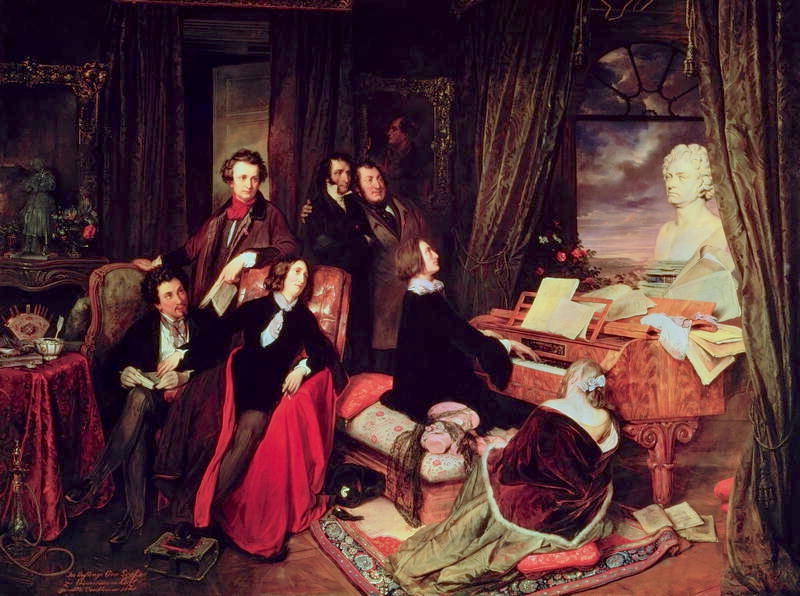
The Evolution of Music in the Romantic Era
The Romantic period (1820–1900 AD) marked a shift toward emotional intensity and individual expression. Composers sought to evoke deep feelings, often drawing inspiration from literature, nature, and personal experiences.
Orchestras expanded in size, allowing for richer and more dramatic soundscapes. Composers experimented with new harmonies, longer melodies, and dynamic contrasts. Program music, which told stories through instrumental compositions, became popular.
Key figures of the Romantic era included Frédéric Chopin, Richard Wagner, and Pyotr Ilyich Tchaikovsky. Chopin’s piano compositions showcased delicate and expressive phrasing. Wagner’s operas featured elaborate orchestrations and dramatic storytelling. Tchaikovsky’s ballets, including “Swan Lake” and “The Nutcracker,” remain timeless masterpieces.
Nationalism also influenced Romantic music. Composers incorporated folk melodies and cultural themes into their works. This movement strengthened regional identities and diversified musical styles.
By the late 19th century, composers began exploring new sounds, leading to early 20th-century innovations.
The Evolution of Music in the Early 20th Century
The early 20th century introduced groundbreaking musical styles. Jazz, blues, and ragtime emerged in the United States, revolutionizing global music culture. These genres featured syncopated rhythms, improvisation, and expressive melodies.
Technological advancements transformed the music industry. Phonographs, radios, and recordings allowed artists to reach wider audiences. Performers like Louis Armstrong and Duke Ellington brought jazz into mainstream popularity.
Classical composers also experimented with new techniques. Igor Stravinsky’s “The Rite of Spring” shocked audiences with dissonant harmonies and unconventional rhythms. George Gershwin blended jazz with orchestral music, creating iconic compositions like “Rhapsody in Blue.”
As music evolved, cultural and technological shifts continued shaping its direction. The rise of recorded music set the stage for future genres, from rock and pop to electronic and hip-hop.
The Modern Era Music
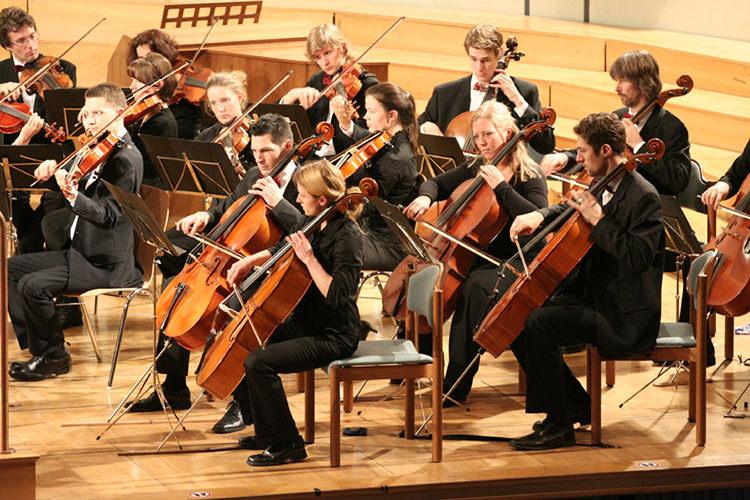
he Evolution of Music in the modern era has been shaped by rapid technological advancements, shifting cultural trends, and the globalization of sound. As a result, music has become more diverse, accessible, and influential than ever before. Because of innovations in recording, distribution, and performance, artists now have more opportunities to reach global audiences. Consequently, genres have blended, creating entirely new musical styles that redefine artistic boundaries.
The Evolution of Music in the Rock and Pop Movements
Since the mid-20th century, rock and pop music have dominated global charts, revolutionizing mainstream sound. While early rock drew inspiration from blues, jazz, and country, it quickly developed into a distinct genre with amplified instruments, strong rhythms, and powerful lyrics. As a result, pioneers like Chuck Berry, Elvis Presley, and Little Richard introduced an electrifying energy that captivated audiences. At the same time, The Beatles and The Rolling Stones pushed rock music into new creative directions, making it a cultural phenomenon.
As rock music evolved, multiple subgenres emerged. Because of technological advancements, musicians experimented with psychedelic rock, progressive rock, and heavy metal. Meanwhile, punk rock rejected elaborate production in favor of raw, energetic performances. Eventually, alternative rock and grunge gained popularity, influencing 1990s bands like Nirvana and Radiohead. Consequently, rock continued adapting to changing musical tastes, ensuring its lasting impact.
Simultaneously, pop music became a global force. Since pop music focuses on catchy melodies and mass appeal, it quickly gained widespread popularity. As a result, artists such as Michael Jackson, Madonna, and Prince redefined entertainment with innovative performances and genre-blending hits. Over time, pop music incorporated elements from R&B, hip-hop, and electronic dance music, ensuring its evolution alongside cultural shifts.
The Evolution of Music in the Digital Age
Because of the digital revolution, music consumption changed dramatically. While physical albums once dominated the industry, digital downloads and streaming services quickly replaced them. Consequently, platforms like iTunes, Spotify, and Apple Music allowed listeners to access millions of songs instantly. As a result, independent artists gained unprecedented exposure, breaking free from traditional record label constraints.
At the same time, new genres emerged, reshaping the musical landscape. Since hip-hop evolved from 1970s Bronx street culture, it grew into one of the most influential genres worldwide. Because of artists like Tupac Shakur, Jay-Z, and Eminem, hip-hop became a platform for storytelling, social commentary, and innovation. Over time, trap music and drill introduced fresh sounds, ensuring the genre’s continued dominance.
Moreover, electronic dance music (EDM) gained massive popularity. Because of advancements in synthesizers, digital workstations, and production software, electronic artists could craft complex soundscapes. As a result, DJs like David Guetta, Calvin Harris, and Avicii blended electronic beats with mainstream pop, leading to explosive global success. At the same time, music festivals like Tomorrowland and Coachella became major cultural events, attracting millions of fans.
Additionally, social media transformed the way artists connect with audiences. Since platforms like YouTube, TikTok, and Instagram provide instant exposure, musicians no longer need record deals to gain popularity. Consequently, viral hits and streaming statistics now determine success, rather than traditional album sales. As a result, independent artists like Billie Eilish and Lil Nas X skyrocketed to fame without major label support.
Ultimately, The Evolution of Music in the modern era remains ongoing. Because of constant innovation, new sounds will continue emerging. At the same time, classic influences will persist, inspiring future generations. Since music reflects cultural changes, its journey will never truly end. Consequently, music will always evolve, shaping and connecting people across time.
The Evolution of Music Across Different Countries
The evolution of music has shaped diverse cultures, creating unique sounds and rhythms. Many countries have made remarkable contributions.
Japan developed traditional music using koto, shamisen, and taiko drums. Shinto rituals and Noh theater influenced these musical styles. The Edo period refined court music, while J-pop blended Western and Japanese melodies.
Korea introduced gugak, featuring pansori and sanjo, which shaped modern K-pop. Brazilian music evolved through samba and bossa nova, blending indigenous, African, and Portuguese traditions. These styles influenced Latin jazz and pop.
Argentina created tango, known for its passion and dramatic movements. Australian Aboriginal music relied on the didgeridoo and rhythmic chants for storytelling. These traditions still influence modern Australian artists.
Russia combined folk melodies with Orthodox Church chants, inspiring classical composers like Tchaikovsky. Hungarian and Romanian folk music introduced violin and cimbalom, shaping jazz and classical compositions.
Turkey’s Ottoman classical music merged Persian, Arabic, and Byzantine influences. Its intricate melodies continue to define Turkish music. Each country adds unique elements, ensuring the evolution of music never stops.
Conclusion
The Evolution of Music has always reflected cultural shifts, technological progress, and artistic creativity. As a result, each era introduced innovations that transformed musical expression. Over time, ancient melodies evolved into structured compositions, while new instruments expanded musical possibilities. Consequently, every genre contributed to shaping the diverse sounds heard today.
Moreover, technological advancements have consistently redefined how people create, share, and experience music. Because of digital platforms, artists can now reach global audiences instantly. In addition, streaming services and social media have revolutionized music discovery. Therefore, modern music continues to evolve, blending tradition with digital innovation.
Ultimately, The Evolution of Music remains an ongoing journey. Since musical trends constantly change, new styles will continue emerging. At the same time, classic influences will persist, inspiring future generations. Undoubtedly, music will always connect people, preserve culture, and shape human expression across time.
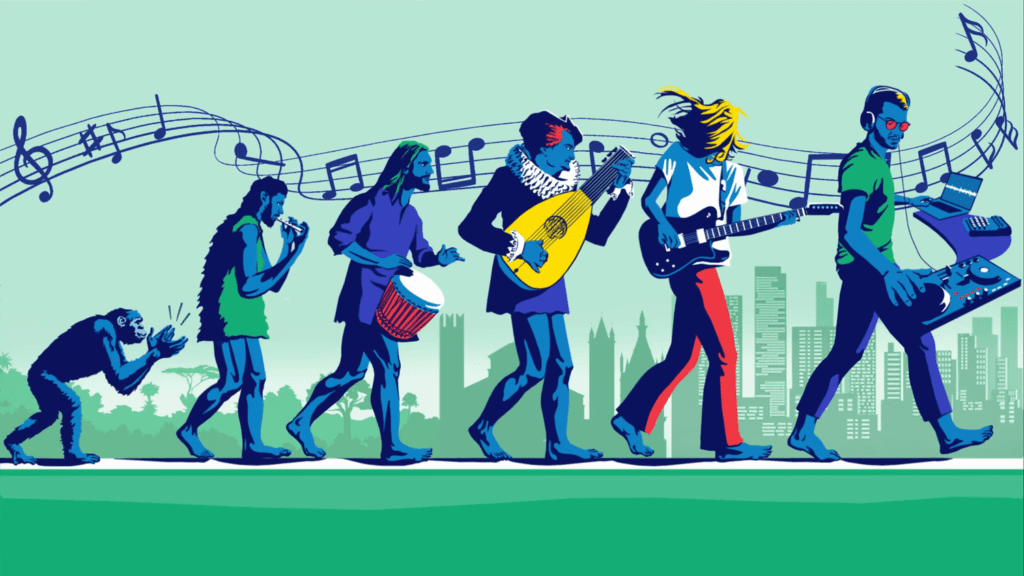
Want to explore more fascinating insights about music? Check out and browse through our collection of exciting music-related blogs. From the science of melodies to tips on mastering your favorite instrument, we cover it all. Stay tuned for more engaging musical content!
For more information and exciting resources about learning music, visit our website at The Mystic Keys. For more music content and exciting offers follow us on
Facebook, Instagram, YouTube, LinkedIn, Twitter, Pinterest, Reddit, Threads, and Quora.
Related Blogs
Evolution of Carnatic Music
Carnatic vocal music, a cornerstone of Indian classical music, boasts a rich and intricate history spanning centuries. Its evolution is a fascinating journey marked by the contributions of countless musicians and scholars.
Comparing Hindustani & Carnatic Music | Key Differences
Music transcends boundaries and unites people, but the nuances and distinctions within various musical traditions make each one unique and fascinating. Indian classical music, one of the world’s oldest and richest traditions, divides into two major styles:………………
Unique Music Concepts around the world | From Ragas to Rhythms
Music is a universal language. It transcends borders and speaks to people of all cultures. For millennia, it has been an integral part of human life. It evolves across societies and blends with local customs, beliefs, and traditions. Each culture brings its unique flavor to music.




